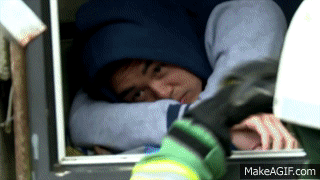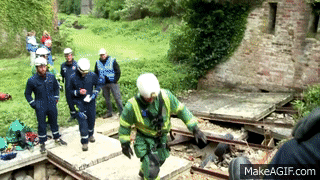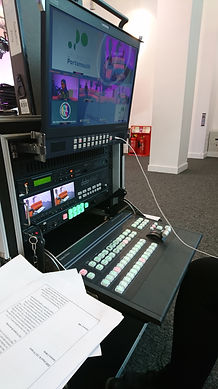
Roles undertaken with technology used while in the role.
I went into university knowing I love Television and Broadcasting, but having no knowledge or skill on the software and technology that would allow me to not only succeed, but thrive, in the industry.
Each Role Listed below will refer to specific instances where I have used this technology and what I have learned. Hopefully it will also tell you what professional technology and software I have some training in.
Click images to locate websites for software and technology
Industry Definitions are from CreativeSkillSet.org




ASSISTANT EDITOR (Emergency Services show)
INDUSTRY DEFINITION:
-
Being the Director's right-hand person, taking responsibility for a number of important practicalities so that the Director is free to concentrate on the creative process
-
Breaking down the script into a shot-by-shot storyboard, working with the Director to determine the shoot order, and how long each scene will take to film
-
Drawing up the shooting schedule (a timetable for the filming) and making sure it’s kept to it.
WHAT I DID:
I re-edited a VT (Video Tape/Insert) from provided archive footage, for the team, to broadcast standard. Using archive footage was a lot harder than producing something from scratch because you have to look through the footage provided to create a narrative. Where as when you produce and edit you own video you already have one in mind when getting filming the shots. Although the shots provided were stylistically enjoyable to watch, the quality of the footage was not that great. During the creation of the first Live show for the emergency services I helped one of the editors find the narrative and re-edit the Disaster and Emergency VT. After using Avid Pan and Zoom I was able to play with a few of the archive shots to help pace the sequence in a watchable manner; specifically bringing out the urgency and panic that we wanted to highlight. After I created a new sequence, I used Avid resize and the stabilize tools to adjust the shots, and then used Davinci Resolve to enhance the colouring in order to make each of the original footage match.
As assistant editor my role varied from that expected in the industry as the editor and I were collaborating a lot, and I had a larger role in the creation process. It was a fun new experience editing with archive footage and allowed me to practice on creating narratives with already filmed footage. One the other hand, I would have liked a longer turn around period to producer the VT as I was only given a day to submit it for broadcast. This was extremely short due to the fact the editors original submission not being appropriator for broadcast.
TECH USED / LEARNT
Infinitely Scalable Intelligent Storage (ISIS) to store Archive footage and editing project.
Avid Media Composer was used to edit the VT together.
Davinci Resolve for Colour Correction.


PRODUCER (In the Outside broadcast)
INDUSTRY DEFINITION:
-
Turning story ideas into profitable films
-
Putting together a creative and talented cast and crew
-
Being responsible for all aspects of a film's production
WHAT I'M DOING:
Producing an outside broadcast with the Mary Rose Museum and the University of Portsmouth for the final year show. My role as the producer has been a stressful, but fulfilling one. I need to learn to delegate more and not put all the pressure on myself.
After a miscommunication a video shoot had to be postponed and re-organised. Learning from mistakes seems to be a good way people learn, including myself, however, now I am more diligent in checking every detail twice when it comes to email communications.
Thankfully all of the production meetings with the Mary Rose Trust team have been very specific, allowing us to get a lot of ideas down on page. The direction I had in mind for the show seemed to work well with the brief, and we came to the conclusion that the people behind the raising of the Mary Rose were going to be the main focus. Through the use of personal accounts and archive footage, I hope to portray the personalities of those involved while also revealing stories that have never been mentioned on camera before! Although, I knew producing would be a hard role to fulfill, I feel confident in producing the Final year broadcast with the production team I have.
Having a good production team is really helpful when producing, however, having so many strong personalities and outspoken people in one group can become overwhelming. On the other hand, if I ever need a solution or idea and I have to many things going on, I can trust someone in the team will have a great idea to use. Working in teams has really helped me come out of my shell and enjoy sharing my ideas, even if they are not perfect.
Producing the Live show means I have to make sure everyone in the team is focused, doing the roles they were assigned, and making sure deadlines are met. It also means that I need to know my show inside and out. Including every guest, each link, and trust that my directors know what I want out of the final show. It was easy to write ideas down, but bringing them to life is harder. After going to the Museum at least 4 times, locations for video shoots, and camera shots have been outlined, which takes a lot of the pressure off. With dates fast approaching it is easy to see how fast time really goes when producing a show!
TECH USED / LEARNT
Sony FS7K cameras
Sony UWP-D11 Radio Mics
Newtek TriCaster tcxd 800
Data Video Mobile Video
talkback boxes
Want to hear more about the equipment we use to broadcast and how the signal gets from one location to your screens? Just click the video to the left to watch.




DIRECTOR
INDUSTRY DEFINITION:
-
Being responsible for the look and sound of a production and its technical standards
-
Enhancing, refining and realising original ideas into finished programmes
WHAT I DID:
As the Director for Sustainability Show I ventured into the realm of creativity when filming video shoots. It was my Job to direct the show from the main gallery in the CCI Studio and make sure everyone knew what was going to happen next. Directing was a fun job, and I was more calm than I originally thought I would be. However, I had had one session of practice at being a director when my course leader threw me in the deep end on an open day. As I was the most familiar with the show I was a good choice, and I really had no need for hesitation. I believe if you make sure you know the running order and content of your show you really can't mess up. Additionally, as director it was down to me to make sure everything that we broadcast looked at its best, meaning I had to have a good eye for detail.
TECH USED / LEARNT
Lectrosonics IFBT4 paired with IFBr1a
VISION MIXER & TRICASTER
INDUSTRY DEFINITION:
-
Editing programmes live (as they are being transmitted or recorded), using a variety of transition methods, such as cuts, mixes, wipes and frame manipulation
WHAT I DID:
For someone who came to university with no technical background, it's amazing how confident I feel when I see a piece of equipment as complex as the Newtek TriCaster. With over eight camera feeds, sound, graphics, Video inserts and Live keyed sets, the TriCaster is confusing but a lot of fun. After a few practices of integrating the TriCaster and vision mixing role, it became a lot easier to control the visual outputs in the live show. I decided to have a one on one session with a technician in order to really understand what each button did within the system. Allowing me further opportunity to use the equipment for a longer period of time, helping me gain confidence when the Live show eventually came around.
If given the chance to use this equipment again I would feel confident navigating between each feature and Keying backgrounds for Live graphics.
TECH USED / LEARNT
Intergrated Production system:
Newtek TriCaster tcxd 800 &
Vision Mixing board


For Extra research (more technical) click the image above
INDUSTRY DEFINITION:
-
Helping record the best quality sound in studios or on locations, working closely with Sound Supervisors and Boom Operators
WHAT I DID:
As a sound operator for University Open Day productions it became very easy to switch between the different boards in the studio's, such as the Behringer Eurorack UB2442FX-PRO sound mixer. However, I became more familiar with the Sound craft Si expression digital live sound console in the White Swan Studio. Sounds confusing right? Well after looking at it and nearly having a panic attack, I decided to have another one on one with a technician. He helped me see that controlling the microphones was exactly the same, a few features have different names, and you can control the audio limiters in the same way. IT became very clear to me that transferable skills are picked up without realising it.
After realising what features were which and how to link up the microphones my only job was to monitor the sound in the live show and make sure there was no peaking.
TECH USED / LEARNT
Behringer Eurorack UB2442FX-PRO
Sound craft Si expression digital live sound console

SOUND OPERATOR

BROADCAST ASSISTANT
INDUSTRY DEFINITION:
-
Offering support to Producers and Presenters
-
Performing a wide range of key administrative tasks to ensure the smooth running of radio programmes
-
Helping with research, planning and production
WHAT I DID:
Aditionally on the open days it was the team and I who had to set up all of the equipment ready for broadcast. For the first few demonstrations it looked like all the wires were the same, every camera had a dozen buttons, and the autocue and sound booth just had a life of its own. It only took me a few time of setting up and getting hands on for me to work out the difference between all of the cabeling, how to run each cable in order for a working camera enviroment, and how to set up a Data Video Mobile Studio. I think if I had to set the equipment up my own now I wouldn't even question myself, and get it down without a hiccup.
TECH USED / LEARNT
Layout and Set up of a Data Video Mobile Studio and Cables.




CAMERA OPERATOR
INDUSTRY DEFINITION:
-
Supporting the Director of Photography and the Director with shot composition and development on high budget productions
-
Being responsible for all aspects of camera preparation and operation
WHAT I DID:
It was my job as a camera operator to ensure all of the cameras were formatted correctly, manually set up to the location settings and to make sure all the shots were in focus. I really enjoy being a camera operator as you get a chance to try new shots and styles. However, I feel if the cameras have no movement during the show then people can tend to get bored. On the other hand, being a camera operator means you have to be on your toes at all time just in case the directer calls for another shot, or a re-frame.
TECH USED / LEARNT
Sony SF7K cameras
Sony JVC600



VT CAMERA CREW

INDUSTRY DEFINITION:
-
Operating and managing equipment
-
Films all Inserts for a show
WHAT I DID:
After directing and camera work, becoming part of a team that shot on location filming became second nature to me. The KEY is to always get more than enough cutaways! With out enough cutaways you're stuck with an interview where someone is most likely staring at the camera talking directly to your audience for way to long. In the instance of filming the LandRover BAR interviews during the sustainability show, it was clear that only a few of the members of the team wanted to engage with the camera. It was our job to draw them out with questions they knew they could answer, and help them feel more comfortable before we asked the real interview questions.
On this shoot we had two cameras, however only one was linked to the audio. Meaning that when it came to edit the sequence, the video needed to be re-linked to the audio. Normally this wouldn't have been a problem, but because of the second cameras constant movements, stopping and starting of recording and having no reference point (for instance a clapper board) I defiantly had a difficult time re-linking all the audio by ear. Fortunately, with Avid there is a tool where you can see the spikes in the audio which allowed me to find certain mouth movements to match to the specific sounds.
Next time when I attend a video shoot I will make sure that there is either a clap at the beginning to link the video and audio faster, or make sure both cameras have audio linked directly to them.
An annoying yet necessary evil for location shoots is the paperwork. Having the correct paperwork is crucial in case of an accident, or hazards. We had to learn to fill out a broadcast standard risk assessment and get it signed by two faculty members, make sure everyone involved signs a release form, and don't start filming until the location agreement is signed. If you have missed one of these you either cannot broadcast, or all of the footage you gathered on that shoot is rendered mute. Not getting release forms and location agreements signed would be one of the biggest errors you could make on the day of a shoot.
TECH USED / LEARNT
Sennheiser K6 Shotgun with Blimp Casing
Sont EX3
Sony Radio Mic Kits
Mixpre
SCRIPT WRITER & Researcher
INDUSTRY DEFINITION:
-
Creating various works of written content
-
Using a large vocabulary and understanding of structure and piece to write engaging pieces
-
Originating or developing programme ideas, drawing on knowledge and understanding of industry requirements, and presenting findings to decision makers
-
Checking facts and briefing writers who write scripts for on-screen presenters
WHAT I DID:
Script writing is not really something that can be shown through pictures, yet without it there would be no show. If you have a bad script it doesn't matter who your presenters are you are in for a very bumpy ride. After doing hours and hours of research I finally new what I wanted to add to the script and what needed to be left out. However, one the script was finished, it was time to re-write, re-phrase and re-word, all in order to make the script flow as though spoken naturally and not off a screen. I did find this a difficult part of the process as I am much better at writing fiction screen plays. Although, by the end of the show the feeling of satisfaction I gained from hearing my writing being broadcast to the Big Screen was pretty amazing.

Sound Editing & Design
INDUSTRY DEFINITION:
-
Creating sounds effects for giant explosions or car crashes
-
Creating more subtle sounds to enhance mood and feeling
-
Managing the sound post production process
WHAT I DID:
Creating a package for radio broadcast was very difficult as I find it hard to only edit audio. However, with the help of another student, I finally learnt how to use Audacity to edit the audio. Audacity was an easy way to cut the package together and gave me free rain to add at least six audio tracks in order to producer an interesting piece. Additionally, creating the soundscape of a hospital room, and using music which changed from sad to uplifting allowed the audio to hold more depth to the story being told by the guests.
Sound design is a great skill to understand, and really is fun to be I just hope I get the chance to keep learning.
TECH USED / LEARNT
Audacity







